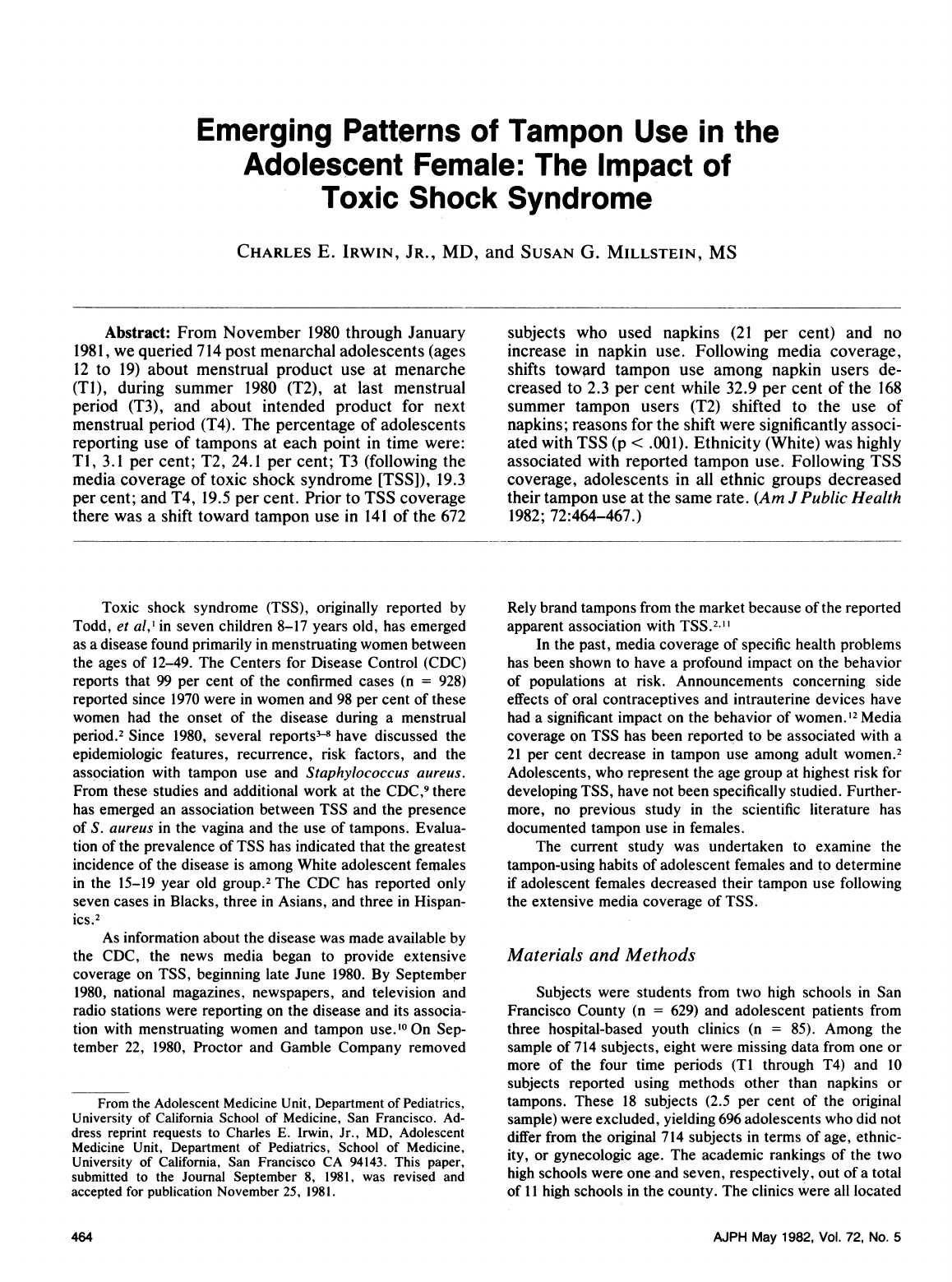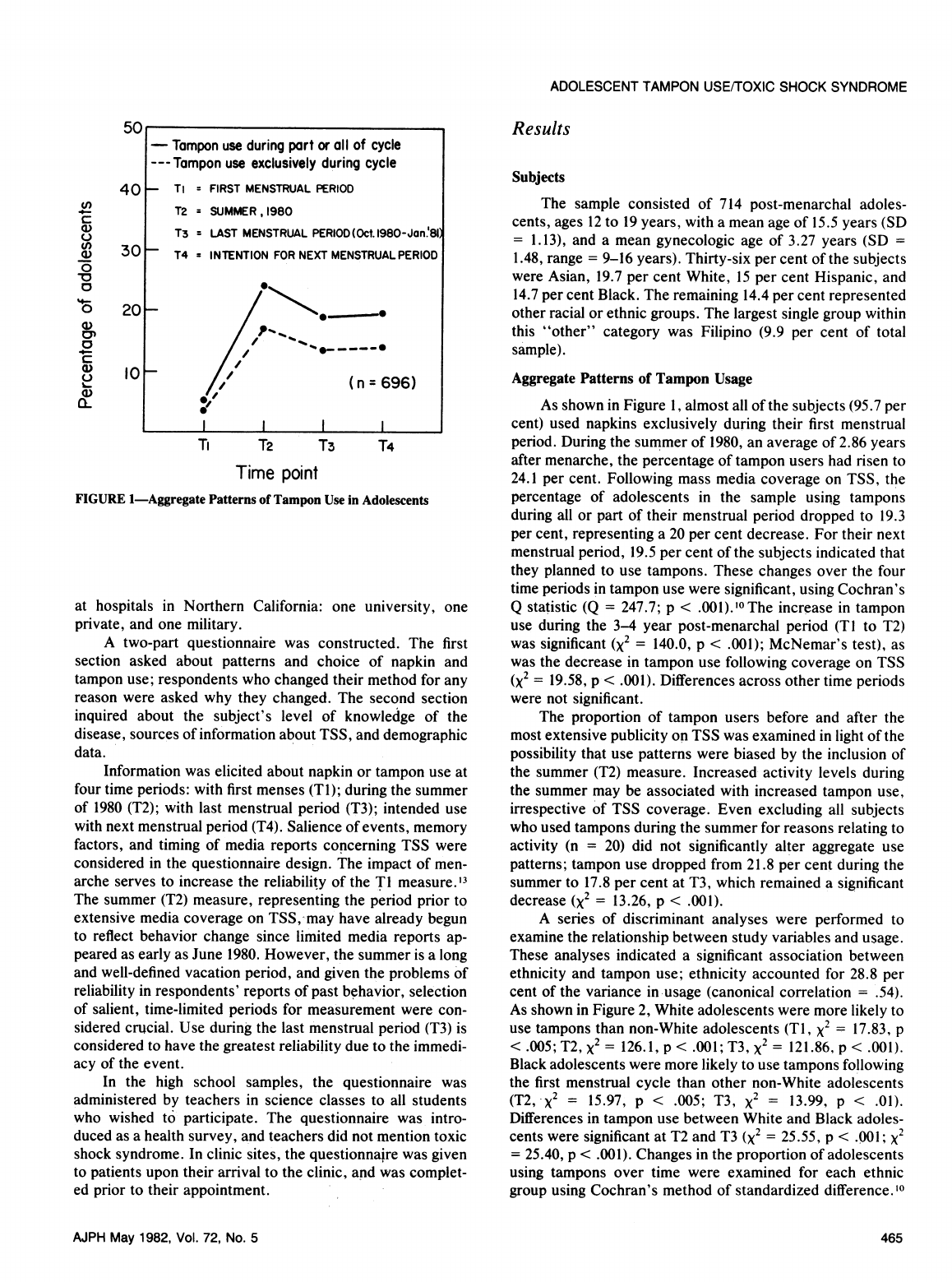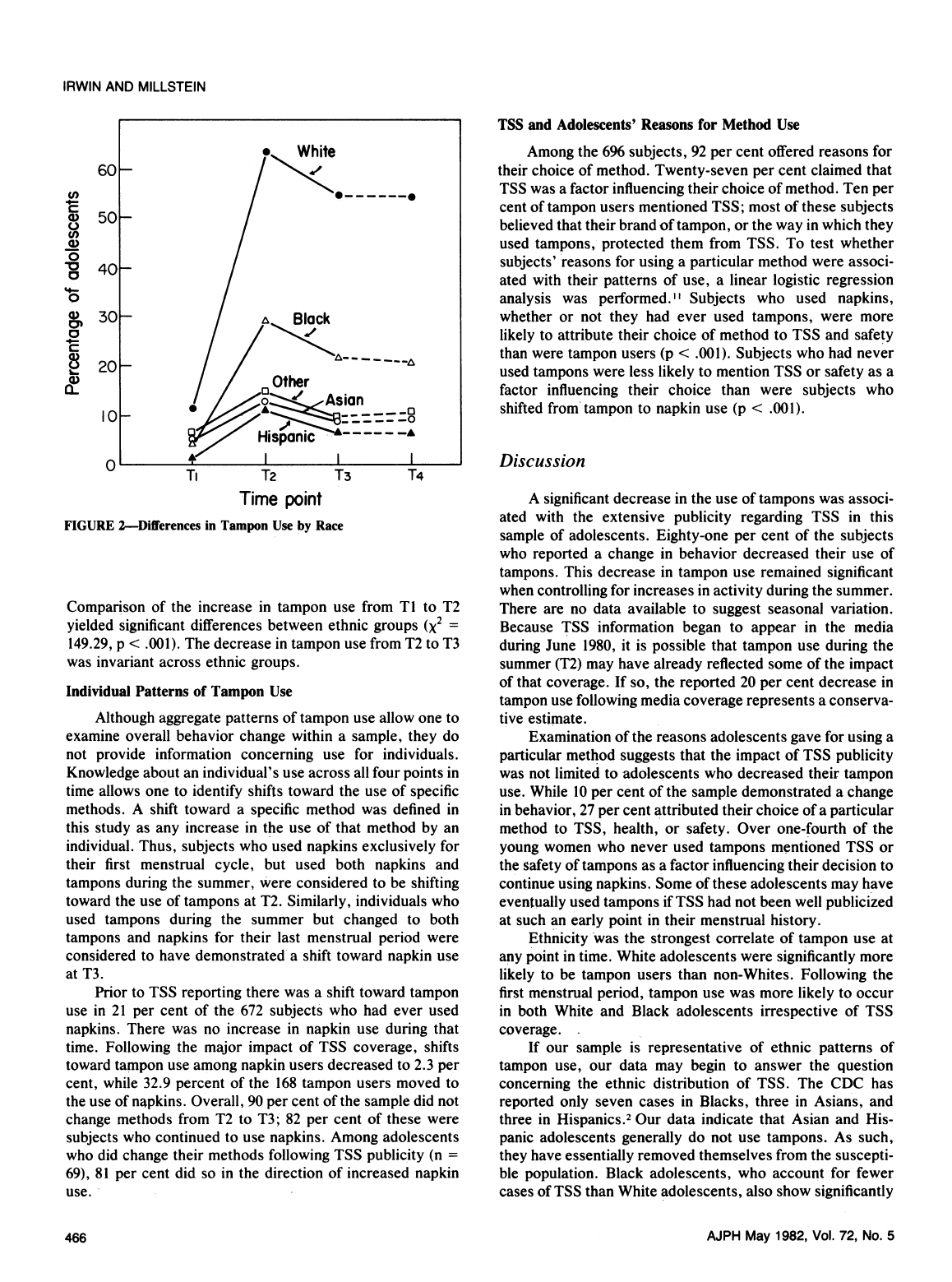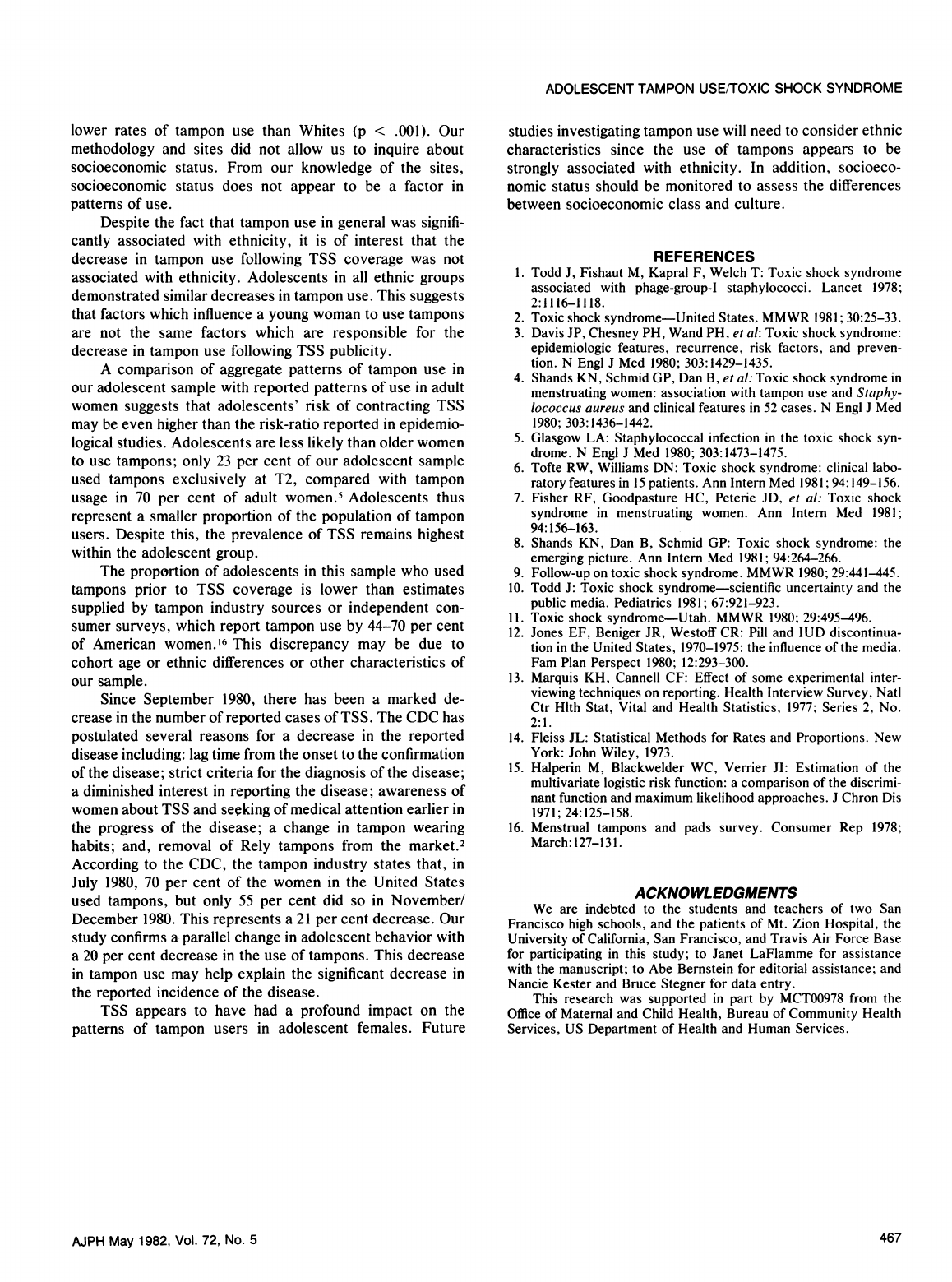
Emerging
Patterns
of
Tampon
Use
in
the
Adolescent
Female:
The
Impact
of
Toxic
Shock
Syndrome
CHARLES
E.
IRWIN,
JR.,
MD,
and
SUSAN
G.
MILLSTEIN,
MS
Abstract:
From
November
1980
through
January
1981,
we
queried
714
post
menarchal
adolescents
(ages
12
to
19)
about
menstrual
product
use
at
menarche
(TI),
during
summer
1980
(T2),
at
last
menstrual
period
(T3),
and
about
intended
product
for
next
menstrual
period
(T4).
The
percentage
of
adolescents
reporting
use
of
tampons
at
each
point
in
time
were:
TI,
3.1
per
cent;
T2,
24.1
per
cent;
T3
(following
the
media
coverage
of
toxic
shock
syndrome
[TSS]),
19.3
per
cent;
and
T4,
19.5
per
cent.
Prior
to
TSS
coverage
there
was
a
shift
toward
tampon
use
in
141
of
the
672
Toxic
shock
syndrome
(TSS),
originally
reported
by
Todd,
et
al,'
in
seven
children
8-17
years
old,
has
emerged
as
a
disease
found
primarily
in
menstruating
women
between
the
ages
of
12-49.
The
Centers
for
Disease
Control
(CDC)
reports
that
99
per
cent
of
the
confirmed
cases
(n
=
928)
reported
since
1970
were
in
women
and
98
per
cent
of
these
women
had
the
onset
of
the
disease
during
a
menstrual
period.2
Since
1980,
several
reports3-8
have
discussed
the
epidemiologic
features,
recurrence,
risk
factors,
and
the
association
with
tampon
use
and
Staphylococcus
aureus.
From
these
studies
and
additional
work
at
the
CDC,9
there
has
emerged
an
association
between
TSS
and
the
presence
of
S.
aureus
in
the
vagina
and
the
use
of
tampons.
Evalua-
tion
of
the
prevalence
of
TSS
has
indicated
that
the
greatest
incidence
of
the
disease
is
among
White
adolescent
females
in
the
15-19
year
old
group.2
The
CDC
has
reported
only
seven
cases
in
Blacks,
three
in
Asians,
and
three
in
Hispan-
ics.
2
As
information
about
the
disease
was
made
available
by
the
CDC,
the
news
media
began
to
provide
extensive
coverage
on
TSS,
beginning
late
June
1980.
By
September
1980,
national
magazines,
newspapers,
and
television
and
radio
stations
were
reporting
on
the
disease
and
its
associa-
tion
with
menstruating
women
and
tampon
use.'0
On
Sep-
tember
22,
1980,
Proctor
and
Gamble
Company
removed
From
the
Adolescent
Medicine
Unit,
Department
of
Pediatrics,
University
of
California
School
of
Medicine,
San
Francisco.
Ad-
dress
reprint
requests
to
Charles
E.
Irwin,
Jr.,
MD,
Adolescent
Medicine
Unit,
Department
of
Pediatrics,
School
of
Medicine,
University
of
California,
San
Francisco
CA
94143.
This
paper,
submitted
to
the
Journal
September
8,
1981,
was
revised
and
accepted
for
publication
November
25,
1981.
subjects
who
used
napkins
(21
per
cent)
and
no
increase
in
napkin
use.
Following
media
coverage,
shifts
toward
tampon
use
among
napkin
users
de-
creased
to
2.3
per
cent
while
32.9
per
cent
of
the
168
summer
tampon
users
(T2)
shifted
to
the
use
of
napkins;
reasons
for
the
shift
were
significantly
associ-
ated
with
TSS
(p
<
.001).
Ethnicity
(White)
was
highly
associated
with
reported
tampon
use.
Following
TSS
coverage,
adolescents
in
all
ethnic
groups
decreased
their
tampon
use
at
the
same
rate.
(Am
J
Public
Health
1982;
72:464-467.)
Rely
brand
tampons
from
the
market
because
of
the
reported
apparent
association
with
TSS.2"1'
In
the
past,
media
coverage
of
specific
health
problems
has
been
shown
to
have
a
profound
impact
on
the
behavior
of
populations
at
risk.
Announcements
concerning
side
effects
of
oral
contraceptives
and
intrauterine
devices
have
had
a
significant
impact
on
the
behavior
of
women.
12
Media
coverage
on
TSS
has
been
reported
to
be
associated
with
a
21
per
cent
decrease
in
tampon
use
among
adult
women.2
Adolescents,
who
represent
the
age
group
at
highest
risk
for
developing
TSS,
have
not
been
specifically
studied.
Further-
more,
no
previous
study
in
the
scientific
literature
has
documented
tampon
use
in
females.
The
current
study
was
undertaken
to
examine
the
tampon-using
habits
of
adolescent
females
and
to
determine
if
adolescent
females
decreased
their
tampon
use
following
the
extensive
media
coverage
of
TSS.
Materials
and
Methods
Subjects
were
students
from
two
high
schools
in
San
Francisco
County
(n
=
629)
and
adolescent
patients
from
three
hospital-based
youth
clinics
(n
=
85).
Among
the
sample
of
714
subjects,
eight
were
missing
data
from
one
or
more
of
the
four
time
periods
(Tl
through
T4)
and
10
subjects
reported
using
methods
other
than
napkins
or
tampons.
These
18
subjects
(2.5
per
cent
of
the
original
sample)
were
excluded,
yielding
696
adolescents
who
did
not
differ
from
the
original
714
subjects
in
terms
of
age,
ethnic-
ity,
or
gynecologic
age.
The
academic
rankings
of
the
two
high
schools
were
one
and
seven,
respectively,
out
of
a
total
of
11
high
schools
in
the
county.
The
clinics
were
all
located
AJPH
May
1982,
Vol.
72,
No.
5
464

ADOLESCENT
TAMPON
USE/TOXIC
SHOCK
SYNDROME
50
(I)
cn
a)
a)
0
V
4-
U1)
C.)
40
-
Ti
=
FIRST
MENSTRUAL
PERIOD
30
_
20
_-
lO1_
I
I
TI
I
T,
T2
T3
T4
Time
point
FIGURE
1-Aggregate
Patterns
of
Tampon
Use
in
Adolescents
at
hospitals
in
Northern
California:
one
university,
one
private,
and
one
military.
A
two-part
questionnaire
was
constructed.
The
first
section
asked
about
patterns
and
choice
of
napkin
and
tampon
use;
respondents
who
changed
their
method
for
any
reason
were
asked
why
they
changed.
The
second
section
inquired
about
the
subject's
level
of
knowledge
of
the
disease,
sources
of
information
about
TSS,
and
demographic
data.
Information
was
elicited
about
napkin
or
tampon
use
at
four
time
periods:
with
first
menses
(Tl);
during
the
summer
of
1980
(T2);
with
last
menstrual
period
(T3);
intended
use
with
next
menstrual
period
(T4).
Salience
of
events,
memory
factors,
and
timing
of
media
reports
concerning
TSS
were
considered
in
the
questionnaire
design.
The
impact
of
men-
arche
serves
to
increase
the
reliability
of
the
T1
measure.'3
The
summer
(T2)
measure,
representing
the
period
prior
to
extensive
media
coverage
on
TSS,-may
have
already
begun
to
reflect
behavior
change
since
limited
media
reports
ap-
peared
as
early
as
June
1980.
However,
the
summer
is
a
long
and
well-defined
vacation
period,
and
given
the
problems
of
reliability
in
respondents'
reports
of
past
behavior,
selection
of
salient,
time-limited
periods
for
measurement
were
con-
sidered
crucial.
Use
during
the
last
menstrual
period
(T3)
is
considered
to
have
the
greatest
reliability
due
to
the
immedi-
acy
of
the
event.
In
the
high
school
samples,
the
questionnaire
was
administered
by
teachers
in
science
classes
to
all
students
who
wished
to
participate.
The
questionnaire
was
intro-
duced
as
a
health
survey,
and
teachers
did
not
mention
toxic
shock
syndrome.
In
clinic
sites,
the
questionnaire
was
given
to
patients
upon
their
arrival
to
the
clinic,
and
was
complet-
ed
prior
to
their
appointment.
Results
Subjects
The
sample
consisted
of
714
post-menarchal
adoles-
cents,
ages
12
to
19
years,
with
a
mean
age
of
15.5
years
(SD
=
1.13),
and
a
mean
gynecologic
age
of
3.27
years
(SD
=
1.48,
range
=
9-16
years).
Thirty-six
per
cent
of
the
subjects
were
Asian,
19.7
per
cent
White,
15
per
cent
Hispanic,
and
14.7
per
cent
Black.
The
remaining
14.4
per
cent
represented
other
racial
or
ethnic
groups.
The
largest
single
group
within
this
"other"
category
was
Filipino
(9.9
per
cent
of
total
sample).
Aggregate
Patterns
of
Tampon
Usage
As
shown
in
Figure
1,
almost
all
of
the
subjects
(95.7
per
cent)
used
napkins
exclusively
during
their
first
menstrual
period.
During
the
summer
of
1980,
an
average
of
2.86
years
after
menarche,
the
percentage
of
tampon
users
had
risen
to
24.1
per
cent.
Following
mass
media
coverage
on
TSS,
the
percentage
of
adolescents
in
the
sample
using
tampons
during
all
or
part
of
their
menstrual
period
dropped
to
19.3
per
cent,
representing
a
20
per
cent
decrease.
For
their
next
menstrual
period,
19.5
per
cent
of
the
subjects
indicated
that
they
planned
to
use
tampons.
These
changes
over
the
four
time
periods
in
tampon
use
were
significant,
using
Cochran's
Q
statistic
(Q
=
247.7;
p
<
.001).
'
The
increase
in
tampon
use
during
the
3-4
year
post-menarchal
period
(TI
to
T2)
was
significant
(X2
=
140.0,
p
<
.001);
McNemar's
test),
as
was
the
decrease
in
tampon
use
following
coverage
on
TSS
(X2
=
19.58,
p
<
.001).
Differences
across
other
time
periods
were
not
significant.
The
proportion
of
tampon
users
before
and
after
the
most
extensive
publicity
on
TSS
was
examined
in
light
of
the
possibility
that
use
patterns
were
biased
by
the
inclusion
of
the
summer
(T2)
measure.
Increased
activity
levels
during
the
summer
may
be
associated
with
increased
tampon
use,
irrespective
of
TSS
coverage.
Even
excluding
all
subjects
who
used
tampons
during
the
summer
for
reasons
relating
to
activity
(n
=
20)
did
not
significantly
alter
aggregate
use
patterns;
tampon
use
dropped
from
21.8
per
cent
during
the
summer
to
17.8
per
cent
at
T3,
which
remained
a
significant
decrease
(X2
=
13.26,
p
<
.001).
A
series
of
discriminant
analyses
were
performed
to
examine
the
relationship
between
study
variables
and
usage.
These
analyses
indicated
a
significant
association
between
ethnicity
and
tampon
use;
ethnicity
accounted
for
28.8
per
cent
of
the
variance
in
usage
(canonical
correlation
=
.54).
As
shown
in
Figure
2,
White
adolescents
were
more
likely
to
use
tampons
than
non-White
adolescents
(TI,
=
17.83,
p
<
.005;
T2,
X2
=
126.1,
p
<
.001;
T3,
X2
=
121.86,
p
<
.001).
Black
adolescents
were
more
likely
to
use
tampons
following
the
first
menstrual
cycle
than
other
non-White
adolescents
(T2,
X2
=
15.97,
p
<
.005;
T3,
x2
=
13.99,
p
<
.01).
Differences
in
tampon
use
between
White
and
Black
adoles-
cents
were
significant
at
T2
and
T3
(X2
=
25.55,
p
<
.001;
X2
=
25.40,
p
<
.001).
Changes
in
the
proportion
of
adolescents
using
tampons
over
time
were
examined
for
each
ethnic
group
using
Cochran's
method
of
standardized
difference.'0
AJPH
May
1982,
Vol.
72,
No.
5
-Tampon
use
during
part
or
all
of
cycle
---Tampon
use
exclusively
during
cycle
T2
=
SUMMER,
1980
T3
a
LAST
MENSTRUAL
PERIOD(Oct.1980-Jon.81)
T4
x
INTENTION
FOR
NEXT
MENSTRUAL
PERIOD
0/
(
n
=
696)
//
~~~(n
=696)
465

IRWIN
AND
MILLSTEIN
0I
40-
a)5
4
30
-
A
Blac
01
20
-
Other
10
Ti
T2
T3
T4
Time
point
FIGURE
2-Differences
in
Tampon
Use
by
Race
Comparison
of
the
increase
in
tampon
use
from
Tl
to
T2
yielded
significant
differences
between
ethnic
groups
(X2
=
149.29,
p
<
.001).
The
decrease
in
tampon
use
from
T2
to
T3
was
invariant
across
ethnic
groups.
Individual
Patterns
of
Tampon
Use
Although
aggregate
patterns
of
tampon
use
allow
one
to
examine
overall
behavior
change
within
a
sample,
they
do
not
provide
information
concerning
use
for
individuals.
Knowledge
about
an
individual's
use
across
all
four
points
in
time
allows
one
to
identify
shifts
toward
the
use
of
specific
methods.
A
shift
toward
a
specific
method
was
defined
in
this
study
as
any
increase
in
the
use
of
that
method
by
an
individual.
Thus,
subjects
who
used
napkins
exclusively
for
their
first
menstrual
cycle,
but
used
both
napkins
and
tampons
during
the
summer,
were
considered
to
be
shifting
toward
the
use
of
tampons
at
T2.
Similarly,
individuals
who
used
tampons
during
the
summer
but
changed
to
both
tampons
and
napkins
for
their
last
menstrual
period
were
considered
to
have
demonstrated'
a
shift
toward
napkin
use
at
T3.
Prior
to
TSS
reporting
there
was
a
shift
toward
tampon
use
in
21
per
cent
of
the
672
subjects
who
had
ever
used
napkins.
There
was
no
increase
in
napkin
use
during
that
time.
Following
the
major
impact
of
TSS
coverage,
shifts
toward
tampon
use
among
napkin
users
decreased
to
2.3
per
cent,
while
32.9
percent
of
the
168
tampon
users
moved
to
the
use
of
napkins.
Overall,
90
per
cent
of
the
sample
did
not
change
methods
from
T2
to
T3;
82
per
cent
of
these
were
subjects
who
continued
to
use
napkins.
Among
adolescents
who
did
change
their
methods
following
TSS
publicity
(n
=
69),
81
per
cent
did
so
in
the
direction
of
increased
napkin
use.
TSS
and
Adolescents'
Reasons
for
Method
Use
Among
the
6%
subjects,
92
per
cent
offered
reasons
for
their
choice
of
method.
Twenty-seven
per
cent
claimed
that
TSS
was
a
factor
influencing
their
choice
of
method.
Ten
per
cent
of
tampon
users
mentioned
TSS;
most
of
these
subjects
believed
that
their
brand
of
tampon,
or
the
way
in
which
they
used
tampons,
protected
them
from
TSS.
To
test
whether
subjects'
reasons
for
using
a
particular
method
were
associ-
ated
with
their
patterns
of
use,
a
linear
logistic
regression
analysis
was
performed.
"
Subjects
who
used
napkins,
whether
or
not
they
had
ever
used
tampons,
were
more
likely
to
attribute
their
choice
of
method
to
TSS
and
safety
than
were
tampon
users
(p
<
.001).
Subjects
who
had
never
used
tampons
were
less
likely
to
mention
TSS
or
safety
as
a
factor
influencing
their
choice
than
were
subjects
who
shifted
from'tampon
to
napkin
use
(p
<
.001).
Discussion
A
significant
decrease
in
the
use
of
tampons
was
associ-
ated
with
the
extensive
publicity
regarding
TSS
in
this
sample
of
adolescents.
Eighty-one
per
cent
of
the
subjects
who
reported
a
change
in
behavior
decreased
their
use
of
tampons.
This
decrease
in
tampon
use
remained
significant
when
controlling
for
increases
in
activity
during
the
summer.
There
are
no
data
available
to
suggest
seasonal
variation.
Because
TSS
information
began
to
appear
in
the
media
during
June
1980,
it
is
possible
that
tampon
use
during
the
summer
(T2)
may
have
already
reflected
some
of
the
impact
of
that
coverage.
If
so,
the
reported
20
per
cent
decrease
in
tampon
use
following
media
coverage
represents
a
conserva-
tive
estimate.
Examination
of
the
reasons
adolescents
gave
for
using
a
particular
method
suggests
that
the
impact
of
TSS
publicity
was
not
limited
to
-adolescents
who
decreased
their
tampon
use.
While
10
per
cent
of
the
sample
demonstrated
a
change
in
behavior,
27
per
cent
attributed
their
choice
of
a
particular
method
to
TSS,
health,
or
safety.
Over
one-fourth
of
the
young
women
who
never
used
tampons
mentioned
TSS
or
the
safety
of
tampons
as
a
factor
influencing
their
decision
to
continue
using
napkins.
Some
of
these
adolescents
may
have
eventually
used
tampons
if
TSS
had
not
been
well
publicized
at
such
an
early
point
in
their
menstrual
history.
Ethnicity'was
the
strongest
correlate
of
tampon
use
at
any
point
in
time.
White
adolescents
were
significantly
more
likely
to
be
tampon
users
than
non-Whites.
Following
the
first
menstrual
period,
tampon
use
was
more
likely
to
occur
in
both
White
and
Black
adolescents
irrespective
of
TSS
coverage.
If
our
sample
is
representative
of
ethnic
patterns
of
tampon
use,
our
data
may
begin
to
answer
the
question
concerning
the
ethnic
distribution
of
TSS.
The
CDC
has
reported
only
seven
cases
in
Blacks,
three
in
Asians,
and
three
in
Hispanics.2
Our
data
indicate
that
Asian
and
His-
panic
adolescents
generally
do
not
use
tampons.
As
such,
they
have
essentially
removed
themselves
from
the
suscepti-
ble
population.
Black
adolescents,
who
account
for
fewer
cases
of
TSS
than
White
adolescents,
also
show
significantly
AJPH
May
1982,
Vol.
72,
No.
5
466

ADOLESCENT
TAMPON
USE/TOXIC
SHOCK
SYNDROME
lower
rates
of
tampon
use
than
Whites
(p
<
.001).
Our
methodology
and
sites
did
not
allow
us
to
inquire
about
socioeconomic
status.
From
our
knowledge
of
the
sites,
socioeconomic
status
does
not
appear
to
be
a
factor
in
patterns
of
use.
Despite
the
fact
that
tampon
use
in
general
was
signifi-
cantly
associated
with
ethnicity,
it
is
of
interest
that
the
decrease
in
tampon
use
following
TSS
coverage
was
not
associated
with
ethnicity.
Adolescents
in
all
ethnic
groups
demonstrated
similar
decreases
in
tampon
use.
This
suggests
that
factors
which
influence
a
young
woman
to
use
tampons
are
not
the
same
factors
which
are
responsible
for
the
decrease
in
tampon
use
following
TSS
publicity.
A
comparison
of
aggregate
patterns
of
tampon
use
in
our
adolescent
sample
with
reported
patterns
of
use
in
adult
women
suggests
that
adolescents'
risk
of
contracting
TSS
may
be
even
higher
than
the
risk-ratio
reported
in
epidemio-
logical
studies.
Adolescents
are
less
likely
than
older
women
to
use
tampons;
only
23
per
cent
of
our
adolescent
sample
used
tampons
exclusively
at
T2,
compared
with
tampon
usage
in
70
per
cent
of
adult
women.5
Adolescents
thus
represent
a
smaller
proportion
of
the
population
of
tampon
users.
Despite
this,
the
prevalence
of
TSS
remains
highest
within
the
adolescent
group.
The
proportion
of
adolescents
in
this
sample
who
used
tampons
prior
to
TSS
coverage
is
lower
than
estimates
supplied
by
tampon
industry
sources
or
independent
con-
sumer
surveys,
which
report
tampon
use
by
44-70
per
cent
of
American
women.'6
This
discrepancy
may
be
due
to
cohort
age
or
ethnic
differences
or
other
characteristics
of
our
sample.
Since
September
1980,
there
has
been
a
marked
de-
crease
in
the
number
of
reported
cases
of
TSS.
The
CDC
has
postulated
several
reasons
for
a
decrease
in
the
reported
disease
including:
lag
time
from
the
onset
to
the
confirmation
of
the
disease;
strict
criteria
for
the
diagnosis
of
the
disease;
a
diminished
interest
in
reporting
the
disease;
awareness
of
women
about
TSS
and
seeking
of
medical
attention
earlier
in
the
progress
of
the
disease;
a
change
in
tampon
wearing
habits;
and,
removal
of
Rely
tampons
from
the
market.2
According
to
the
CDC,
the
tampon
industry
states
that,
in
July
1980,
70
per
cent
of
the
women
in
the
United
States
used
tampons,
but
only
55
per
cent
did
so
in
November/
December
1980.
This
represents
a
21
per
cent
decrease.
Our
study
confirms
a
parallel
change
in
adolescent
behavior
with
a
20
per
cent
decrease
in
the
use
of
tampons.
This
decrease
in
tampon
use
may
help
explain
the
significant
decrease
in
the
reported
incidence
of
the
disease.
TSS
appears
to
have
had
a
profound
impact
on
the
patterns
of
tampon
users
in
adolescent
females.
Future
studies
investigating
tampon
use
will
need
to
consider
ethnic
characteristics
since
the
use
of
tampons
appears
to
be
strongly
associated
with
ethnicity.
In
addition,
socioeco-
nomic
status
should
be
monitored
to
assess
the
differences
between
socioeconomic
class
and
culture.
REFERENCES
1.
Todd
J,
Fishaut
M,
Kapral
F,
Welch
T:
Toxic
shock
syndrome
associated
with
phage-group-l
staphylococci.
Lancet
1978;
2:1116-1118.
2.
Toxic
shock
syndrome-United
States.
MMWR
1981;
30:25-33.
3.
Davis
JP,
Chesney
PH,
Wand
PH,
et
al:
Toxic
shock
syndrome:
epidemiologic
features,
recurrence,
risk
factors,
and
preven-
tion.
N
Engi
J
Med
1980;
303:1429-1435.
4.
Shands
KN,
Schmid
GP,
Dan
B,
et
al:
Toxic
shock
syndrome
in
menstruating
women:
association
with
tampon
use
and
Staphy-
lococcus
aureus
and
clinical
features
in
52
cases.
N
Engi
J
Med
1980;
303:1436-1442.
5.
Glasgow
LA:
Staphylococcal
infection
in
the
toxic
shock
syn-
drome.
N
Engl
J
Med
1980;
303:
1473-1475.
6.
Tofte
RW,
Williams
DN:
Toxic
shock
syndrome:
clinical
labo-
ratory
features
in
15
patients.
Ann
Intern
Med
1981;
94:149-156.
7.
Fisher
RF,
Goodpasture
HC,
Peterie
JD,
et
al:
Toxic
shock
syndrome
in
menstruating
women.
Ann
Intern
Med
1981;
94:156-163.
8.
Shands
KN,
Dan
B,
Schmid
GP:
Toxic
shock
syndrome:
the
emerging
picture.
Ann
Intern
Med
1981;
94:264-266.
9.
Follow-up
on
toxic
shock
syndrome.
MMWR
1980;
29:441-445.
10.
Todd
J:
Toxic
shock
syndrome-scientific
uncertainty
and
the
public
media.
Pediatrics
1981;
67:921-923.
11.
Toxic
shock
syndrome-Utah.
MMWR
1980;
29:495-496.
12.
Jones
EF,
Beniger
JR,
Westoff
CR:
Pill
and
IUD
discontinua-
tion
in
the
United
States,
1970-1975:
the
influence
of
the
media.
Fam
Plan
Perspect
1980;
12:293-300.
13.
Marquis
KH,
Cannell
CF:
Effect
of
some
experimental
inter-
viewing
techniques
on
reporting.
Health
Interview
Survey,
NatI
Ctr
Hlth
Stat,
Vital
and
Health
Statistics,
1977;
Series
2,
No.
2:1.
14.
Fleiss
JL:
Statistical
Methods
for
Rates
and
Proportions.
New
York:
John
Wiley,
1973.
15.
Halperin
M,
Blackwelder
WC,
Verrier
JI:
Estimation
of
the
multivariate
logistic
risk
function:
a
comparison
of
the
discrimi-
nant
function
and
maximum
likelihood
approaches.
J
Chron
Dis
1971;
24:125-158.
16.
Menstrual
tampons
and
pads
survey.
Consumer
Rep
1978;
March:
127-131.
ACKNOWLEDGMENTS
We
are
indebted
to
the
students
and
teachers
of
two
San
Francisco
high
schools,
and
the
patients
of
Mt.
Zion
Hospital,
the
University
of
California,
San
Francisco,
and
Travis
Air
Force
Base
for
participating
in
this
study;
to
Janet
LaFlamme
for
assistance
with
the
manuscript;
to
Abe
Bernstein
for
editorial
assistance;
and
Nancie
Kester
and
Bruce
Stegner
for
data
entry.
This
research
was
supported
in
part
by
MCT00978
from
the
Office
of
Maternal
and
Child
Health,
Bureau
of
Community
Health
Services,
US
Department
of
Health
and
Human
Services.
AJPH
May
1982,
Vol.
72,
No.
5
467
